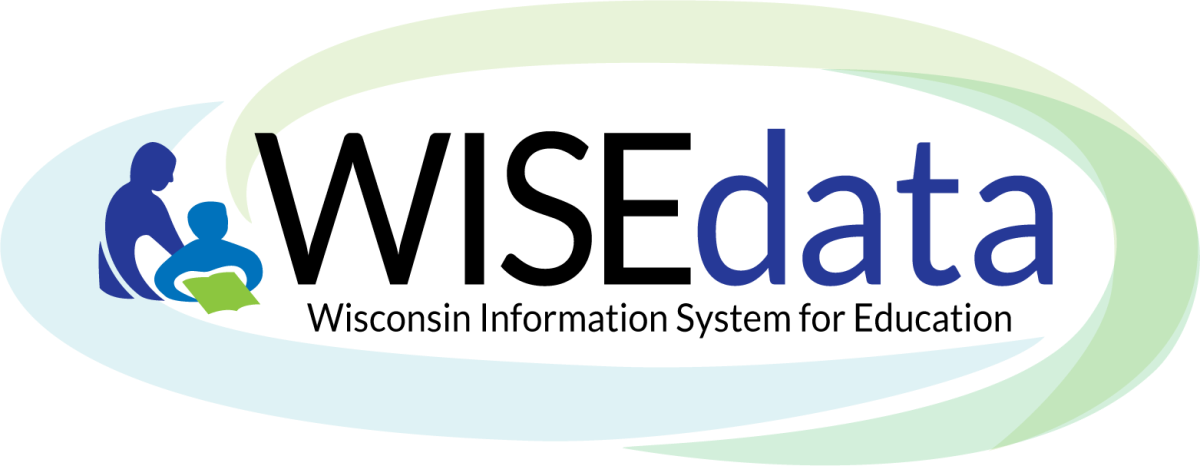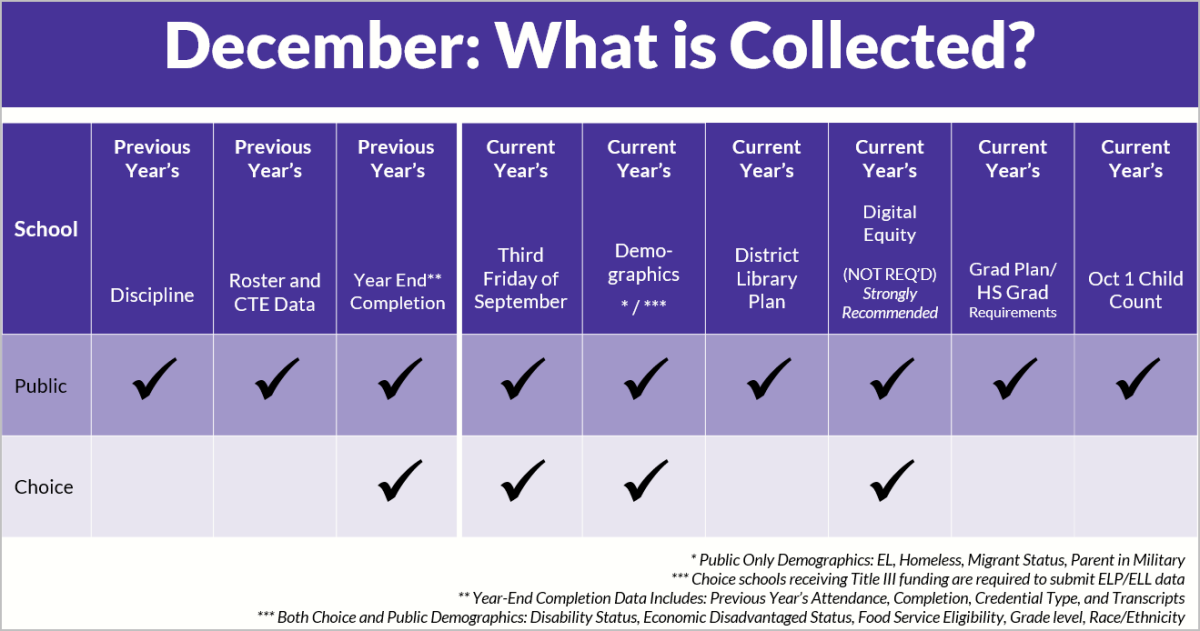
Click the links below to navigate to different sections of this page:
What is a Snapshot?
LEAs collect and share data with DPI every day. The data is live, and ever-changing as corrections are made, new information is added and updates are made.
A snapshot is static - it is taken on a predetermined date. On that date at 9:00 AM (CT) the collection process starts. It is recommend that LEAs focus on resolving existing errors well in advance of the designated snapshot date.
In general terms, snapshots are pieces of data that are copied from active, dynamic tables in the DPI Data Warehouse (DW) at a specific point of time to a “permanent” location. The ‘permanency’ of a snapshot is useful in that it supports current and future, short-term and longitudinal data reporting and data study. The ‘static’ nature of a snapshot also facilitates reporting from an unchanging set of attributes because it provides consistent, repeatable query results that are unaffected by the dynamics of real-world changes and corrections.
Who Participates in Snapshot?
All LEAs that submit data to DPI participate in snapshot reporting.
There are different criteria for different types of LEAs
LEAs collect the following demographics for all students:
-
Race/Ethnicity
-
Gender
-
Grade Level
-
Disability Status
-
Economically Disadvantaged Status
-
Food Services Eligibility
For a detailed list on snapshot requirements, visit the WISEdata Annual Tasks Checklist page, Annual WISEdata Snapshot Collection section. Extend the accordions to see a full list of all snapshot data requirements.
** Choice schools receiving Title III funding are required to report their ELL data (ACCESS score, ELP codes). This ensures compliance with federal guidelines and supports English learners effectively.
- Conversely, for Choice Schools not receiving Title III funding, ELL data remains optional.
Why Do Snapshots?
Snapshots will serve as the permanent data source for certified reporting by DPI. Snapshot data is used for the following:
- Accountability Report Cards
- Federal reporting, including ESSA
- Public Reporting in the WISEdash Public Portal
- Some funding determinations, such as IDEA, high poverty aid, maintenance of effort (MOE), and others.
Snapshot Dates
Track important dates and deadlines in the WISE Events Calendar:
- May 21, 2024: Date of May snapshot for 2023-24 school year
- December 10, 2024: Date of December snapshot
Snapshot dates are set to meet federal and state requirements. The dates are hard and fast. No extensions can be given.
Spring Demographic Snapshot: What's Collected?
May 21, 2024, 9:00 a.m. Central Standard Time

On this day at 9:00 am (CT) the orange "Queue Import & Validation" button in the WISEdata Portal is disabled, preventing LEAs from manually triggering the validation processes. Other aspects of WISEdata Portal, as well as other applications may be "locked" during the morning of snapshot to prevent errors in the system. To support accurate data collection and preempt the need for an errata letter to record changes post-snapshot, we recommend that LEAs to proactively address issues well before snapshot day.
Check the WISE Events Calendar for Regional In-Person Snapshot Preparation sessions around the state! There will also be a virtual training webinar for public schools and for Choice schools. Meanwhile, you can refer to the Q & A from May 12, 2022 WISEdata Spring Demographic Snapshot Open Office Hours.

Data elements collected by BOTH Public and Choice schools:
- Disability Status
- Grade Level
- Gender
- ELL Status
- *EL data must be reported by Choice schools receiving Title III funding.
This ensures compliance with federal guidelines and supports English learners effectively.
- Conversely, for Choice Schools not receiving Title III funding, ELL data remains optional.
- *EL data must be reported by Choice schools receiving Title III funding.
- Economic Disadvantage
- Food Service Eligibility
- Migrant Status (see note about Migrant data above)**
- ** Migrant data is not required for Choice schools, but is highly recommended.
- Race/Ethnicity
- Additional Public Only Demographics:
- Homeless,
- Parent in Military
 Spring Snapshot Training Videos and Slides for 2023-24
Spring Snapshot Training Videos and Slides for 2023-24
Public/Charter Schools: May 2024 Snapshot Training
Choice Schools: May 2024 Snapshot Training
2023-24 School Choice Webinar
Spring Snapshot Training
Student Snapshot: What's Collected?
Tuesday, December 10, 2024, 9:00 a.m. Central Standard Time

On this day at 9:00 am (CT) the orange "Queue Import & Validation" button in the WISEdata Portal is disabled, preventing LEAs from manually triggering the validation processes. To support accurate data collection and preempt the need for an errata letter to record changes post-snapshot, we recommend that LEAs to proactively address issues well before snapshot day.

Data elements Collected by BOTH Public and Choice Schools:
- Year End Completion: Attendance, Term Completion Indicator, Credential Type
- Third Friday of September Enrollment
- All student demographics: Disability Status, ELL Status, Economic Disadvantaged Status, Food Service Eligibility, Gender, Grade Level, Race/Ethnicity
- *** EL data must be reported by Choice schools receiving Title III funding.
This ensures compliance with federal guidelines and supports English learners effectively.
- Conversely, for Choice Schools not receiving Title III funding, ELL data remains optional.
- *** EL data must be reported by Choice schools receiving Title III funding.
- Digital Equity data (Not required but strongly recommended)
- Migrant Status (see note about Migrant data above)**
- ** Migrant data is not required for Choice schools, but is highly recommended.
Data Elements Collected ONLY by Public Schools:
- Career Education, Discipline, October 1 Child Count of students with disabilities, Roster, and Transcripts
- District Library Plan (Submitted through WISEadmin Portal)
- High School Graduation Requirements (Graduation Plan is submitted through WISEdata. More info available on the Graduation Plan Type data element page and the DPI Graduation Requirements webpage.)
- Homeless
- Parent in Military
 December Snapshot Training Videos and Slides for 2022-23
December Snapshot Training Videos and Slides for 2022-23
Public/Charter Schools: December 2023 Snapshot Training
Choice Schools: December 2023 Snapshot Training
2023-24 School Choice Webinar
Wisconsin Choice Data Snapshot Prep
Click the link then click "Watch the Webinar Recording," courtesy of School Choice Wisconsin
Snapshot Resource Links
-
WISEdata Annual Tasks Checklist / Choice Schools Annual Tasks Checklist
- Visit the Snapshot Data Quality Auditing inventory of webpages for details on how to audit your data for various collections, such as Graduation, Economic Disadvantaged Status and more.
Snapshot and Data Errata
![]()
The data sent to WISEdata Portal by Wisconsin schools through their Student Information System(s) (SIS) is a 'live' collection. It is constantly changing with updates, corrections and new submissions.
As stated in the introduction: a snapshot is static - it is taken on a predetermined date to capture the data that exists in WISEdash at the time of the snapshot.
The DPI Customer Services Team has an extensive process of reaching out to our stakeholders by conducting Data Quality outreach (where we reach out to LEAs via electronic communications and phone calls) every August, and continues this through December by answering Help Tickets all they up until the December snapshot date.
What is Data Errata?
Translation of this Latin phrase means, "a correction of published information." Despite all of our best efforts to get data accurate, this process is not perfect and there are times when data is misreported or not reported in time to be accurately represented on the snapshot report. This is when data errata letters come in to play.
NOTE: Data Errata letters are PUBLIC RECORD and SHOULD NOT CONTAIN S/PII!
Once the snapshot has been taken, that report is permanently frozen as is on WISEdash, much as we are in a family photo - it is how we look at that point in time. So, while the snapshot itself cannot be altered, LEAs still have an opportunity to provide the most accurate information they can writing a letter that states the nature of the data errors that were reflected on a snapshot report.
Steps in the Data Errata Process:
- Correct all incorrect data in the WISEdata Portal.
- Write your Data Errata letter. Do not include any personally identifiable information as Data Errata letters are published publicly. Visit the data errata webpage and the data errata WISEstaff data collection page for examples on how to present your corrections with high level language, and other information.
- Data Errata letters are submitted through the WISEadmin Portal.There is additional information on how to submit a Data Errata letter via WISEadmin on the WISEadmin Portal: Info, Help and User Guide webpage in the Data Errata Screen section in the event your LEA does need to submit one.
- If you do not have access to WISEadmin, reach out to your district staff first. You can also visit the WISEhome login page, click, "Need Help Signing In?" and then select one of the available questions that best addresses your situation.
What Data Errata is NOT
It must be very strongly understood, however, that the Data Errata letter does not work as an alternative to getting one's data prepared for snapshot ahead of time. Every LEA is responsible for their Data Quality.
Your Feedback Matters
-
Please provide us with feedback on the Data Errata process. You can give us suggestions about how DPI can make the process more efficient for you.
Snapshot FAQs
-
What are the differences between the snapshot dashboards and the topic dashboards in WISEdash for Districts?
-
The Snapshot dashboards in WISEdash for Districts provide users with tools to query data captured in a snapshot and compare that data to their district’s current data from the main DW tables. These comparisons can help the district identify and correct data reporting deficiencies in preparation for a future snapshot event. For more information on the snapshot dashboards please see the About the Data Snapshots page. Note that the snapshot dashboards provide a way for districts to select the set of students that are/were attending a selected district/school or that are/were accountable by, but not necessarily attending, a given district/school.
-
The topic dashboards in WISEdash for Districts only show data based on the attending district or school/the district that submitted the student records through WISEdata.
-
-
Why doesn’t data in the WISEdata Portal match data in WISEdash for Districts?
-
Data flows nightly from WISEdata into WISEdash for Districts. Note that any data with errors have the potential to impact the data you see in the dashboards. Specific errors that result in data not flowing from WISEdata to WISEdash are noted by the ‘critical’ icon in the WISEdata Portal. An easy way to think about it is that: the data that you see in WISEdata Portal today will be in WISEdash tomorrow.
-
-
Will a student who transferred out continue to show in the WISEdash dashboard?
-
Whether or not a student shows in the dashboard depends on where the student went after leaving your district. If the student transferred to another reporting agency, such as another public district, all reporting accountability follows to the new agency. If the student transferred out of state, homeschool, or to a non-choice private school, your district is still accountable for the student's data as the last reporting agency in WISE for the current school year.
-
Didn't Find What You Needed?
![]()
The Customer Services Team is here to help!
Please submit a Help Ticket so we may better assist you.
Return to top

